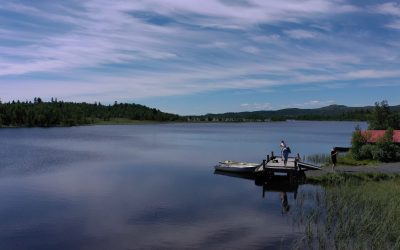The country's heritage and culture
Norwegian cabin culture is a unique and valued part of the country's culture and heritage. With over 400,000 cabins and holiday homes spread across Norway, this is an important phenomenon for a population of just over 5 million people. The Norwegian cabin culture has its origins in two main traditions: the seasonal work of farmers and fishermen, and the country homes of the wealthy for rest and relaxation.
The term "cabin" in Norway has traditionally been used to refer to a small building, often in mountainous areas, by the sea or in forests and fields, intended for short-term accommodation and with few or no modern conveniences. However, this concept has evolved significantly over time. From being simple, small and sober "boots" where only the most necessary things were present, cabins in Norway have largely become luxurious homes away from home, where comfort is an important factor.
Despite this evolution in taste and comfort, many Norwegians still want a strong and close bond with nature, which is reflected in their choice of cabins and their location. This provides a unique blend of tradition and modernity that characterizes Norwegian cabin culture today.
The basics of Norwegian cabin culture
Over the years, cabin culture in Norway has become a big part of the national identity, appealing to both enthusiastic outdoor enthusiasts and those just looking for a break from the hustle and bustle of everyday life.
The typical cabin trip offers an escape from the hustle and bustle of everyday life, providing the opportunity to get closer to nature and enjoy the outdoors. In addition to relaxing and vacationing at the cabin, it's common for Norwegians to explore the local surroundings, either on foot, by bike or on skis.
The mountains and areas around the cabins are ideal for a wide range of recreational activities, such as cross-country skiing, downhill skiing, hiking and fishing. Although many cottage estates have easy access to these activities, there are still many places that maintain a rural and tranquil atmosphere.
Local guides and organizations such as Norsk Hytteforbund, Norsk Hyttelag and Hytteforlaget play an important role in promoting cabin culture in Norway. They provide information about rules and regulations in different municipalities, and offer advice and guidance on cabin construction and operation. In this way, they help to ensure that cabins and cabin sites comply with local policies and environmental considerations.
Watch video of the high-standard cabin field Ølsjølitoppen
Building and architecture
Over the past few decades, cabin culture has grown, and now it is more common to see more luxurious cabins with modern facilities. According to Statistics Norway (SSB, 2023), there are now over 440,000 cabins and holiday homes, an increase of ten percent from ten years ago.
In the past, cabins were simple, with few or no modern conveniences. Rorbuer and setra were primarily used as workers' housing for fishermen and farmers. In the 1900s, it became more popular to build country houses and holiday homes for recreation.
Interior and exterior facilities
Norwegian cabins are known for having a cozy and warm interior that reflects the Norwegian nature and cabin culture. A typical main room inside a Norwegian cabin will consist of a kitchen and living room in one, with plenty of space for cooking and gathering around the table. The kitchen is usually equipped with the essentials needed to prepare simple meals.
In the living room, you'll usually find a fireplace or a stove to keep you warm on cold days, as well as comfortable seating and simple furniture. In terms of sleeping space, cabins will often have a loft or several separate bedrooms with a variety of sleeping arrangements, including bunk beds and double beds. Outside, a typical Norwegian cabin will be surrounded by beautiful scenery, whether it's by the sea, in the forest or up in the mountains.
The cabins are often made from local materials such as wood, and the architecture is classically Norwegian. On the outside, of course, it must be able to withstand both snow and rain.
Leisure activities in nature
Leisure activities in nature are an integral part of the Norwegian cabin culture, and especially if you own a cabin located in the forest and mountains, you will find that there are many opportunities for outdoor activities throughout both summer and winter.
In summer, the areas around the cabins come alive with outdoor activities. From short walks in the local area to more challenging mountain hikes, you can experience everything from idyllic views via fjords and mountain peaks. Cycling is also a fresh way to experience nature.
When winter arrives, the landscape around the cabins transforms into a winter wonderland, perfect for a range of activities not found in densely populated areas. Skiing, both cross-country and downhill, is hugely popular. Especially cabin areas such as Valdres are designed for unique experiences throughout the winter, where you can experience speed and excitement, as well as relaxation in scenic surroundings.
The combination of being able to choose between physical activity in nature or relaxing in peace and quiet is one of the reasons why the cabin culture is as strong as it is in Norway. For many people, cabins also serve as social hubs, where friends and family gather over generations.



